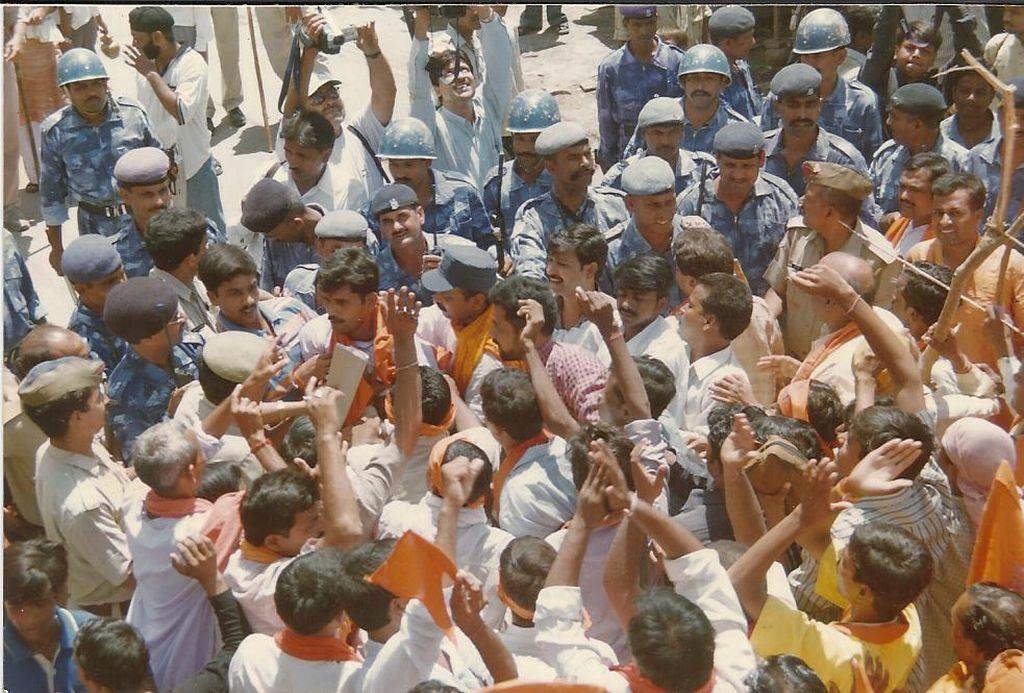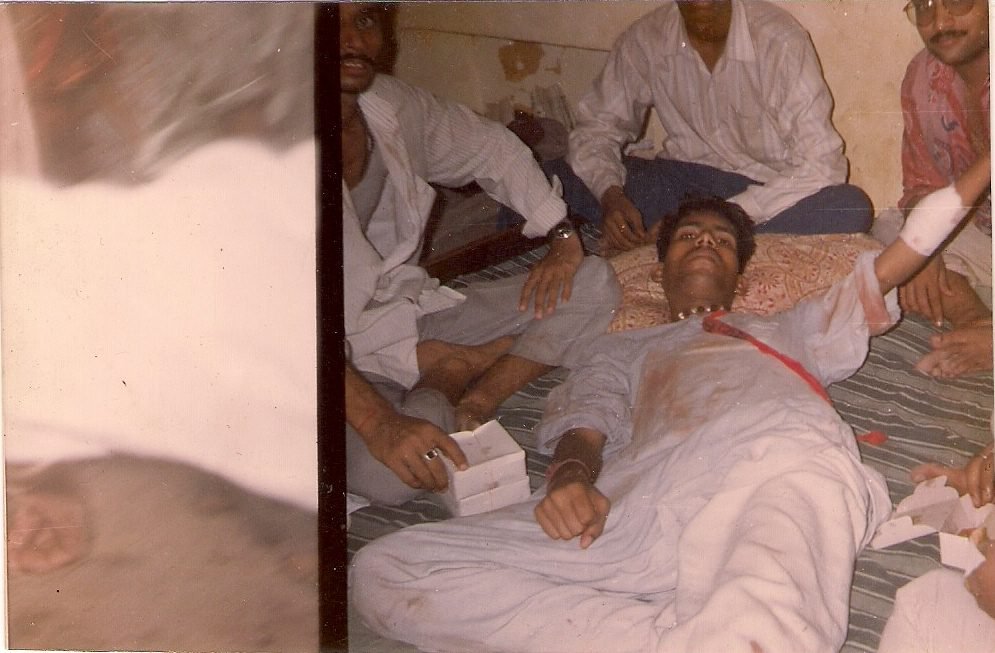I attended Mumbai Gay Pride on August 16th. This date was chosen because the organizers of the event, from the gay community, decided to celebrate their freedom one day after India’s Independence Day on August 15th. They felt that while India gained freedom on that day, the gay community had yet to achieve their own freedom. The event was organized by an NGO called Humsafar, which works with the gay community in Mumbai. I had already been in touch with Humsafar about my project, and they were very welcoming. Although I was in Gwalior for training, I took a 4-day leave and flew to Mumbai, arriving on the night of the 14th.
I had attended this year’s Delhi Pride on June 26th and missed having a video camera. This time, I arranged for one to record the Mumbai Gay Pride. I asked my friend Yogesh, who works in Bollywood, to help me get a camera, and he provided everything I needed. On the 16th, I went to Humsafar with a cameraman and a friend from the US named Ryan, whom I had invited to join me at Mumbai Pride. My goals were to cover the parade preparations, interview a few people at Humsafar and at the parade, participate in the event, enjoy the party, and make new contacts for future collaborations.
I was scheduled to start interviews at Humsafar at noon, but upon arrival, I found several media personnel already interviewing their team. However, they arranged for someone to show me around their office, which was impressive. They had an HIV and AIDS testing center, which I had not seen in other NGOs before. The Humsafar representative took me to the second floor where preparations for the next day’s parade were underway. About 20 people, including some hijras, were practicing dances. They had a drummer playing Punjabi dhol and a large sound system. I was surprised to see them practicing traditional hijra dance.
I spent some time observing the preparations; the enthusiasm and hard work of the performers were evident. The performers were either homosexuals or hijras who sought assistance from Humsafar. The office representative informed me that the CEO of Humsafar, Mr. Vivek Raj Anand, had just arrived and offered me the opportunity to interview him. I felt fortunate to have a 15-minute interview with him, during which he demonstrated his deep knowledge and commitment to the issues.
I believe the gay community has always existed in India, but many view it as a foreign concept. Therefore, when interviewing people about gay culture, I ask about its history in India and its presence in Hindu religious texts. I believe that understanding its historical and religious context can make it easier for people to accept and support it. My goal was to interview people and share these interviews online. I conducted the interviews in Hindi to ensure that people in India could understand them. During the interviews, one interviewee shared stories from the Ramayana and other Hindu texts that indicated the presence of gay culture even during Ram’s time.
He discussed the challenges he faced, societal discrimination, and his hopes for the future. It was enlightening to learn about the history of gay culture in India, especially within Hinduism. Mr. Anand expressed interest in having me work with the MSM (men who have sex with men) community in Benares. He offered to help with funding or projects through the UP government, which was something I was eager to pursue. However, he mentioned that Humsafar does not operate outside Mumbai and Thane districts. They could provide support such as funding or training but would not extend their work beyond these areas.
Since my NGO, Sanjeevani Booti, was not yet registered under section 12A, I would not be able to collaborate with him soon. However, Sanjeevani Booti has now completed its first year, so I can apply for this registration. Mr. Anand also mentioned his gratitude to Baba Ramdev on behalf of the gay community. Baba Ramdev challenged the Delhi High Court’s judgment on Section 377 in the Supreme Court of India. Mr. Anand believed the Supreme Court would soon rule in favor of the gay community, leading to equal rights. I share his appreciation for Baba Ramdev’s efforts.
I interviewed Mr. Anand, the manager of Humsafar, one bisexual individual, two hijras, and a few gay men. It was a valuable experience hearing their stories. Despite their different backgrounds, they faced similar issues, primarily discrimination. The Humsafar manager shared his struggle to obtain a passport with a gender marker reflecting his identity as a female or hijra. Government officials were unfamiliar with the concept of transgender identities, and he had sued the government over this issue. He is currently preparing for a gender change operation but faces obstacles due to the lack of a passport.
I also interviewed a Muslim gay man with two hijras. This was my first interview with a Muslim gay individual. He shared that his family would never accept his desire to marry a man, leaving him with the choice to either escape or remain unmarried. The hijras provided fascinating insights into their community, revealing that there are two types of hijras, each with different customs and levels of respect. I had always been confused about the distinction between “hijra” and “gay.” The hijras explained that educated people use the term “gay,” while uneducated people use “hijra.” They also discussed the challenges faced by the hijra community in India, which mirrored those faced by others I interviewed.
They mentioned the existence of two types of hijras: those who marry a hijra goddess and can live with their families, and those who bless and dance at weddings. One of the bisexual interviewees was a male sex worker. It was my first encounter with a male sex worker, and our conversation was eye-opening. He recounted his experiences and challenges, including an amusing story about mistakenly offering condoms to a policeman. The first day focused on observing preparations and conducting interviews at Humsafar. After finishing the interviews, we waited for an auto-rickshaw when I met Sourendra, a 25-26-year-old who was also gay and frequented Humsafar. We went to a litti-chokha (a famous Bihari food) party with my friend and interviewed Sourendra over dinner at 1 a.m.
I regretted bringing Sourendra to the party because his presence attracted unwanted attention from other guests. Despite the discomfort, Sourendra was open and energetic, discussing his experiences with discrimination and societal expectations. He shared an intriguing story about the existence of gays and hijras during Krishna’s time, which I had never heard before. After the parade, my friend Bijay took me to a renowned restaurant near August Kranti Marg. Following a few beers, we went to Bijay’s hotel and later to a party at a disco. The Mumbai party was distinct from the Delhi party, being organized by participants rather than the parade organizers.
Despite the Rs. 500 entry fee, the party was lively and had a larger turnout, including more lesbian couples. I drank too much and got drunk, witnessing many gay couples showing affection. The Mumbai Gay Pride seemed more organized compared to Delhi’s. There was a van with banners, posters, masks, and t-shirts, though the t-shirts sold out quickly. They also distributed bottled water and had volunteers collecting trash, making it a cleaner event. Many people watched the parade from their balconies, and some joined spontaneously. The Mumbai parade featured more transgenders and hijras than Delhi’s, with a group performing traditional hijra dance.
The parade ended at August Kranti Marg with speeches from social workers and NGO members about gay rights and future plans. I also interviewed a gay couple at the beach nearby. Regarding Section 377’s repeal, I found that everyone I spoke to was happy about it. A participant explained that such laws are crucial for societal change, and while Section 377 did not directly impact gay culture, it altered societal attitudes over time. With its repeal, there is hope for equal rights in the future, even if it may take decades. After the parade, Bijay and I went to a disco party. The Mumbai party, organized by participants, had a higher turnout and was different from Delhi’s.
Although I had to leave early for a 6 a.m. flight back to Bhopal, the party was memorable. Ryan helped me pack and get to the airport. Despite the craziness, I thoroughly enjoyed the trip, meeting new people, learning about their experiences, and establishing connections with Humsafar. They have invited me to the parade next year, and I plan to attend. My friend Sanjay, who initially thought my project was crazy, changed his perspective after hearing the interviews. He now supports equal rights for gays.
The stories I shared about gay culture in Hindu religion helped shift his view. I believe that if more people learn about the historical presence of gays in Hindu culture, acceptance will grow. The main issue behind discrimination against gays in India is a communication gap, especially regarding sex practices, compounded by the 150 years of Section 377. This law deeply affected societal attitudes, but historically, gay practices were part of Hindu culture. The British altered everything, and as we slowly address the issues they left behind, I hope we can also overcome this outdated system.
—





















